Inventory of Canal Corporation Real Property
Fiscal Year Ending December 31, 2015
Description of Real Property under the Jurisdiction of the New York State Canal Corporation
The New York State Canal Corporation has stewardship of, and jurisdiction over, the NYS Canal System, which is comprised, in part, of the State-owned waterways constructed, improved, or designated by authority of the legislature as canals. The NYS Canal System is further described as the channel and adjacent banks of the waterways including canalized rivers and lakes, canal water supply feeder channels and all appertaining structures including locks, dams, bridges, terminals, roadways, aqueducts and other improvements necessary for the proper maintenance and operation of the Canal System. In total, there are over 1,800 improvements necessary for the operation and maintenance of the Canal System located on real property under the Corporation's jurisdiction.
Above-water acreage for the Canal System, which is described as the present Champlain, Erie, Cayuga Seneca and Oswego Canals, northern reservoir lands and remnant formerly abandoned canal lands is approximately 23,000 acres. A currently uncalculated amount of additional submerged (underwater) acres are located along the mainline canal in the land-cut sections and along portions of the canalized river sections (IE: the Mohawk, Hudson and Oswego rivers) as well as "flooded" land containing the Canal reservoirs. Predominantly, above-water real property located along the Canal System is described as long, narrow, linear strips with an average depth of 100-200 feet. Much of the property is often without landside access other than through privately-owned upland parcels, located within the floodplain, and/or contains federal and state wetlands. Sporadically located throughout the Canal System the Corporation holds larger parcels typically used for upland disposal sites for dredged material from the canal or terminal sites for receipt or unloading of cargo. A map depicting the Canal System is attached hereto as Exhibit 1, and more particularly described as follows:
Champlain Canal: The Champlain Canal is the portion of the Canal System connecting the easterly end of the Erie Canal at Waterford, New York with Lake Champlain at Whitehall, New York spanning approximately 60 miles. There are over 2,200 above-water acres of real property located adjacent to the Champlain Canal containing 10 locks, numerous structures and improvements. The Champlain Canal portion of the Canal System is shown attached on Exhibit 2.
Erie Canal: The Erie Canal is the portion of the Canal System connecting the Hudson River at Waterford, New York with the Niagara River at Tonawanda, New York. The Erie Canal is approximately 350 miles long containing numerous structures and improvements, 36 locks, and approximately 15,000 above-water acres, shown on Exhibits 3 and 4.
Oswego Canal: The Oswego Canal is approximately 30 miles long beginning on the Erie Canal at Three Rivers, north to Lake Ontario at Oswego, New York. The Oswego Canal is improved with numerous structures and improvements, contains 8 locks and has approximately 770 acres of un-submerged real property. This portion of the Canal System is attached as Exhibit 5.
Cayuga Seneca Canal: The Cayuga Seneca Canal is the portion of the Canal System connecting the Erie Canal at Tyre, New York through Waterloo, New York to the Seneca and Cayuga Lakes. The Cayuga and Seneca portion contains numerous structures and improvements, 4 locks and approximately 1,100 above-water acres of real property. The Cayuga Seneca Canal portion contains some real property located in both Ithaca and Montour Falls necessary for controlling water levels in the Canal System. The Cayuga Seneca portion of the Canal System is depicted on Exhibit 6 attached hereto.
Northern Reservoirs: North of the Erie Canal, east of the Oswego Canal the Corporation holds in the interest of the people of the State of New York 5 canal reservoirs located inside the Adirondack Park and 5 canal reservoirs located outside the Adirondack Park. The above-water acreage of the Corporation's real property located along these 10 northern reservoirs is approximately 3,000. Generally, the real property around the reservoirs are described as a "bathtub" ring whereby, the Corporation owns a narrow swath of un-submerged land located between an upland abutting owner and the high-water line of the respective reservoir. On average, the bathtub ring around these 10 reservoirs has an average depth of 25-75 feet. The Northern Reservoir real property improvements are limited to roadways, dams and other associated critical infrastructure improvements. The Northern Reservoirs are shown on Exhibit 7.
Exhibit 1
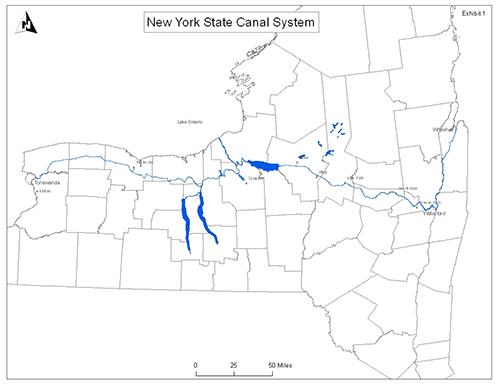
Exhibit 2
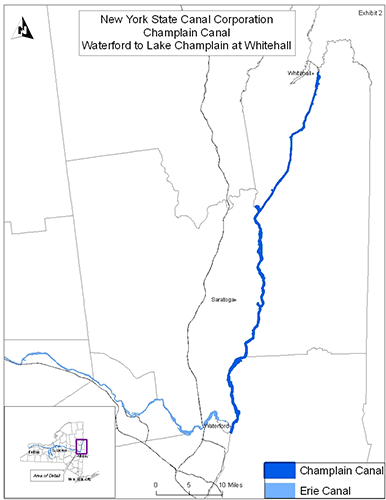
Exhibit 3
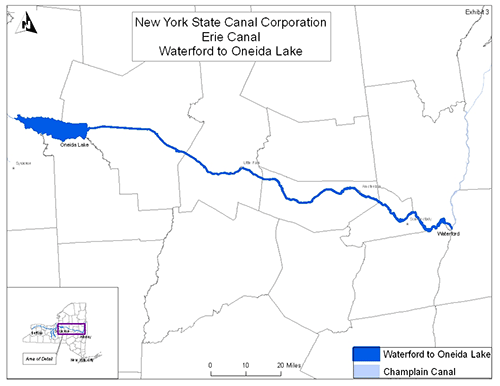
Exhibit 4
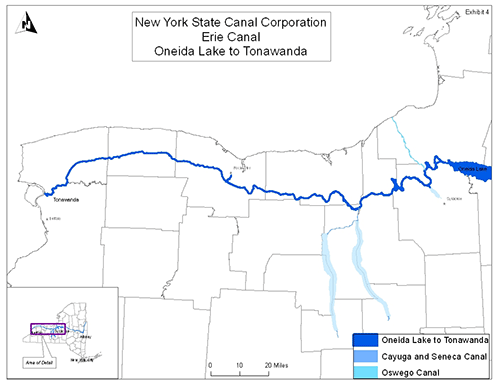
Exhibit 5
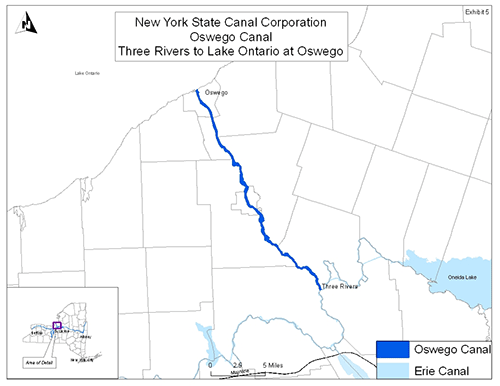
Exhibit 6

Exhibit 7
